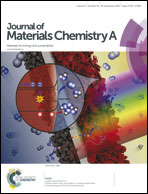Toward high-performance Li(NixCoyMnz)O2 cathodes: facile fabrication of an artificial polymeric interphase using functional polyacrylates†
Abstract
Targeting the long-term performance retention of high-energy-density batteries, a facile yet effective surface coating approach for high-voltage composite cathodes was developed. Ultra-thin polyacrylate (PAA) surface coatings with an estimated thickness of less than 5 nm were integrated onto Li-rich Li(NixCoyMnz)O2 cathodes through a solution-casting method. Obvious improvements of specific charge – around 20 mA h g−1 at the 1st cycle and up to 50 mA h g−1 at the 100th cycle – as well as enhanced capacity retention were achieved post the integration of a lithium polyacrylate (LiPAA) surface coating. A fundamental understanding of the role of PAA coatings was systematically achieved by X-ray photoelectron spectroscopy (XPS), electron microscopy (TEM, SEM/EDX), Fourier transform infrared spectroscopy (FTIR) and online electrochemical mass spectrometry (OEMS). Physically adhesive coatings on the active sites of cathodes were observed, which might contribute to impeded surface reconstruction of active materials during cycling. Furthermore, in OEMS analysis reduced CO2 evolution was detected from coated electrodes, indicating that the LiPAA coating could interrupt electrolyte decomposition reactions and enhance the cathode/electrolyte interfacial stability at high anodic potentials. This functional polymer coating acts as a stable artificial polymeric interphase to mitigate electrode and electrolyte decomposition during long-term cycling.



 Please wait while we load your content...
Please wait while we load your content...